All roses that are grown in temperate climates should be prepared for wintering. This is a need - a large number of varietal plants in conditions of little snow, but cold winters, freeze out. To prevent the death of the bushes, you need to determine - at what temperature it is time to cover the roses for the winter, because in the case of an excessively early warming of the plant, it often fades.
Content
When the roses are covered
Winters in the middle lane are frosty - roses are not always able to move this time without auxiliary shelter. Even provided that many varietal plants can bloom right up to autumn frosts, these varieties cannot independently prepare for a significant drop in temperature. The beginning of the preparation of a decorative-flowering culture for wintering starts in early autumn - under the bushes it is necessary to loosen the soil. By the end of September, all buds are removed, which makes it clear to the rose about the end of the growing season.
The exact time when it is necessary to cover the culture before the winter season depends on the climatic conditions of the region and the varietal affiliation of a particular plant. In addition to a suitable time, regional affiliation determines the necessary type of shelter. In some climatic zones of the country, culture does not need shelters; in other areas, roses must be thoroughly insulated:
- The central zone of the middle zone - the work on warming the roses tentatively begins in late October, the first decade of November.
- Southern regions - the rose does not need serious warming; insignificant preparations for wintering begin in November.
- Moscow region - the climate of this zone is unstable, so the grower must be ready to quickly cover the rose from mid-September. But, the plant is often insulated in mid-late October.
- Volgograd - preparation for wintering begins in approximately the first ten days of November. Complete the process in mid-December.
- Siberia - early warming of bushes often leads to the death of the plant. Since the level of snowfall in the Siberian region is large, the main task for the grower is to create a shelter for the crop for the period when sufficient rainfall has not yet occurred.
- Urals - it is necessary to begin work on preparing rose bushes for wintering in the last decade of October, since the temperature drop in this region is early. In addition, it should be borne in mind that the snow layer is not always sufficient, and the temperature drop in the Ural region is significant.
A decorative-flowering culture is completely covered only after the temperature has gone into a stable minus, which roses cannot survive without additional warming. It is virtually impossible to predict exactly when such a temperature will settle. But, the plant grower can tentatively predict the period in which if he covers the rose, the culture will successfully survive the winter.
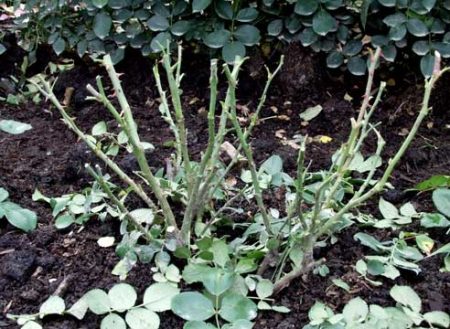 You may be interested in:
You may be interested in:Temperature - when the shelter is not needed yet and when it is required to be erected
The plant is able to easily withstand small temperature drops. So, frosts down to -5 ̊С are not a threat to the plant. With this mark of the thermometer, the culture feels fine and even benefits - a light frost tempers the plant and helps the development of the bush. For this reason, it is undesirable to cover the plant until the end of October. Even in the case of capricious and tender types of tea-hybrid roses, shelter for the winter is not recommended until a more serious drop in temperature.
Representatives of a decorative-flowering culture can withstand temperatures of -7 ° C without catastrophic consequences for their own vitality. Some growers even recommend waiting until the thermometer reaches this limit. Low temperature helps the culture to correctly go to rest, and also increases the immunity of plants due to hardening of the root system and the terrestrial part of the bush.
The factor that determines the temperature suitable for starting insulation work is the ability to maintain dryness within the wintering structure for the rose. Covering the bushes is forbidden with wet soil, wet leaf litter or raw covering materials. Bushes of the plant should also be dry. Following this rule reduces the likelihood of breeding harmful insects, the development of rot and other diseases.
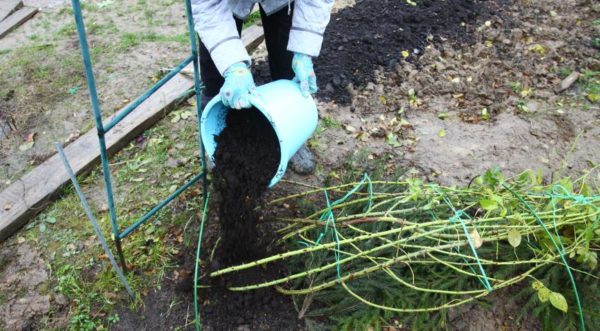
Light shelter
This type of insulation design for wintering flower bushes is built when the winter season in the region is not severe. Often this design is performed after the hardening period for roses, when the air temperature dropped to -7 ̊С, but has not yet dropped to stable -10 or less degrees. In this case, roses can be covered with such materials:
- mulch;
- sawdust;
- lapnik;
- straw;
- foliage.
With a light version of the shelter, the decorative foliage culture is not completely closed. This type of insulation can also be used in the case of regions where in the winter season there is a thick snow layer that protects the delicate plant from the harmful effects of low temperatures (Siberian region and the like). And in the southern regions you can not hide at all for the winter, since in these regions the temperature rarely lingers for a long time at around -10 ̊С or lower.
Capital
The capital type of insulation is erected after the frosts become stable. Often this time in the middle lane and northern regions falls on the end of November or the beginning of December. A thick layer of mulch is poured into the base of the bush, over which spruce branches or some other, similar material is laid. After that, 3-8 stakes are hammered around the perimeter - so that it becomes possible to cover the bush with non-woven material.
On top of the non-woven fabric, it is necessary to fix the film, which will not tear and will not damage the wind. But, it is not recommended to wrap the plant tightly with film, since during winter thaws, the material must be raised from one side to ventilate the bush. This manipulation will also not allow the rose to thaw out due to the increase in temperature under the shelter.
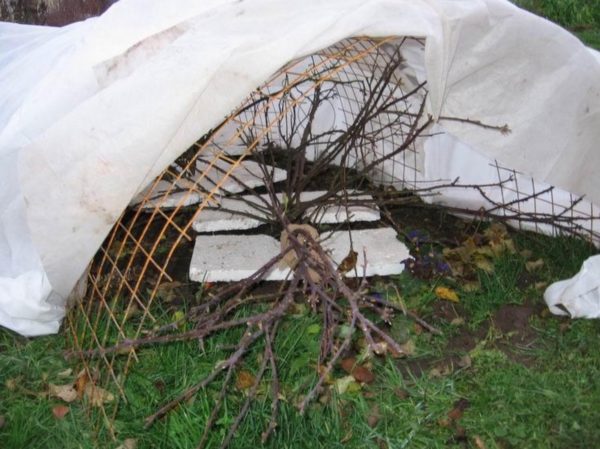
The right ways to shelter a rose
In mid-late autumn, after completion of irrigation and pruning, the root system of a decorative-flowering plant must be properly spudded.A thick soil layer must be present above the rhizomes. After you need to cover the roses with sawdust, dry leaves or grass. You should make sure that under the wintering shelter there are no diseased parts of the plant or moistened mulch. To prevent decay, it is necessary to remove all the foliage from the ground part of the bush.
Type of shelter it is determined depending on the level of the thermometer - when the temperature drops to -40 ̊С, the flower needs to be provided with capital shelter. As a preparation, before the bushes are closed with insulating material, the plant stems are bent to the ground and fixed in this position by specialized hooks. It is possible not to bend the shoots, but cut them close to the ground. Experienced plant growers believe that there are 3 designs for winter insulation, which are better than others:
- wireframe option;
- embankment and fence;
- Shelter of roses by Lutrasil.
Wireframe option
It is possible to build a base for shelter for rose bushes from several metal strips or rods. In addition to metal, it is possible to use sheets of plastic, wicker baskets, plastic large flowerpots, pallets made of wood, boards and the like for the frame base. Arcs are made of metal, the ends of which are buried in the soil around the plant. The process of erecting a shelter involves the following steps:
- Around a bent or cropped rose mark the place.
- The flower grower forms a dome of 2 plates above the bush.
- In severe winter, non-woven covering material is laid over the dome, and the rose is additionally sprinkled with leaf litter or needles.
- The edges of the insulation material are pressed to the ground with bricks from all sides - this will allow, if necessary, to raise the corner and ventilate the plant.
It is desirable to fix the insulation material on the frame after frosts and a stable low temperature in the street, which lasts at least a week and a half. The frame version is convenient in the case of large plantings of roses. Depending on the parameters of the plant, it is possible to erect shelters of 2 types - a conical frame for low-growing varieties and pyramidal / spherical forms for bush varieties.
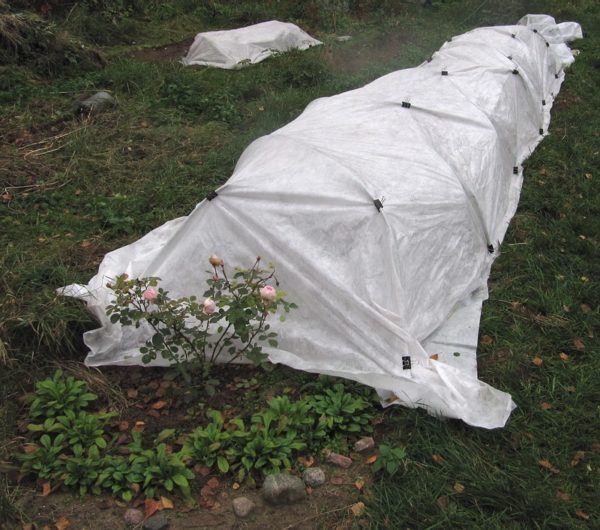
Bulk fence
The option is to dry fill the bush in the form that the plant grower has installed around. As a protective material, it is possible to use a stainless steel mesh, cardboard boxes or thin plywood sheets. A fence of selected material is erected in width and height of a specific plant instance. Insulating material is poured into the enclosed area:
- leaf litter;
- sawdust;
- hay and the like.
Lutrasil Cocoon
Certain tall varietal roses, in particular, standard roses, are wrapped in insulation material for wintering. Matter is wound on a crown, and the stem is left on a support. The root is warmed by hilling. To insulate the stem part of the bush, it is wrapped with lutrasil or similar material. A cocoon is tied in the lower part - so that the frosty air does not penetrate under the insulation.
Does the time for shelter depend on the variety
The most frost-resistant roses are species and representatives of park varieties. Few hybrids are cold resistant. But, even the most hardy representatives of roses need preparation and warming for the winter season, although they are rarely covered in the middle lane.Lack of shelter for the winter is possible only in the southernmost areas. Although there it is necessary to properly prepare the plant for wintering - the rhizomes are earthed up, and pinching and top dressing is completed already in the first ten days of September. In November, the bushes are carefully treated with a plant antiseptic.
In order not to risk the experienced gardeners recommend covering the bushes at least partially even in the southern lane. And with the probability of a temperature drop to -30 ̊С, the flowers need to be fully insulated, even when roses grow on the plot that tolerate minus well. Varieties with higher cold resistance, compared with others, include the following varieties of plant breeders:
- Munch;
- Jens
- Pink Grotendorst;
- Scabrosis
- Ritausma;
- Hansa
- Adelaide Houtles;
- Golden Celebration.
Hybrid tea, exotic, climbing and miniature varieties of roses are less resistant to cold. Such plants must be provided with full protection for the entire cold season. Such varieties are spudded for the winter, insulated from above, it is often necessary to even bury them in the soil. For a good winter, a climbing rose is recommended to cover with a film or ruberoid cloak.
Misconceptions
The procedure for preparing roses for the winter season is of interest and concern to flower growers. Even experienced plant growers are often at the mercy of misconceptions and make the same mistakes from year to year when preparing shrubs for wintering. These misconceptions are not always harmless and often enough cause a slowdown in plant development, lack of flowering, and sometimes death of the specimen.
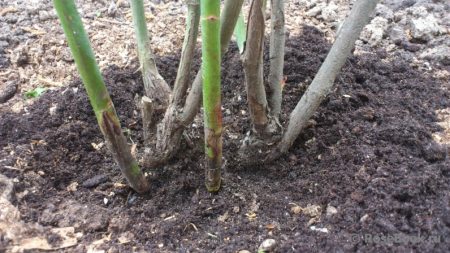 You may be interested in:
You may be interested in:The more capital - the better
The main protection of the bush from the cold is not the insulation material, but the air gap in the gap between the shoots of the plant and the matter. For this reason, the warmest option of shelter is a powerful frame, creating a large warm air gap, and a snow layer on top of the structure. But, when the air temperature is not too low, it becomes hot and humid under warming. In such circumstances, such a shelter can lead to the beginning of the debate of the plant, and then to its death.
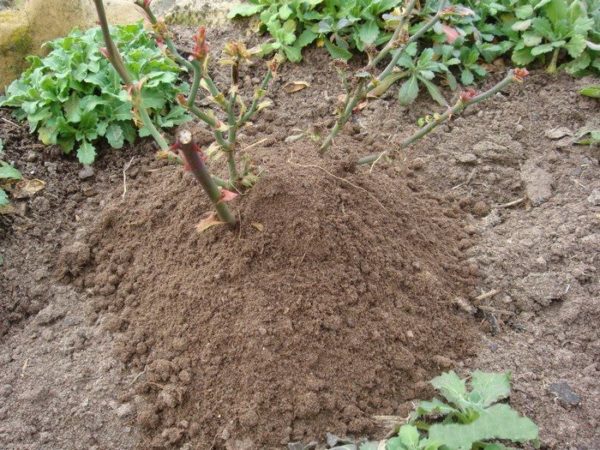
Phosphorus and potassium - the only thing necessary for a successful wintering
Plant needs top dressing in the fall, but to increase the resistance of the flower, the rose needs not only phosphorus and potassium preparations, but also other top dressings containing calcium, magnesium and other elements. In this case, it is necessary to ensure that the autumn fertilizer does not contain nitrogen. Top dressing in the fall is only a supportive and immune-enhancing measure; without shelter, in severe frosts, roses will not survive.
All roses for the winter are cut short
Bushes of decorative flowering culture need pruned and this procedure is mandatory in the case of preparing the plant for wintering. But, there are several length options - medium, short and long. A short version rejuvenates the flower, but negatively affects frost resistance. Long with annual repetition leads to a decrease in flowering intensity. There are certain rules that a plant grower must observe:
- Pruning is done on a calm day, when there is no precipitation, and air humidity is low.
- Cut off shoots only with a sharpened tool - this will minimize damage to the bush. When the pruner is dull, it pinches the shoot, which can lead to a specific plant instance to death.
- Shoots are removed only at an acute angle, and the cut is directed to the center of the bush.
- The place of cut from the extreme kidney must be located not less than 1.5 cm.
- The bud, which will give rise to new stems, must look outside the bush. This situation will expand and give splendor to the rose. But, when it is necessary that the shoots are directed vertically, and the lateral shoots are absent, it is necessary to leave a kidney looking inside the bush.
Before wintering, you need to spud flowers
Hilling roses for the winter is recommended, but this procedure is not always only beneficial for the plant. During the thaw period, the bush can become warm, and with subsequent cooling, this will result in cracking of the bark. A mandatory hilling procedure is only for root roses that have been grown from cuttings. Only their root system is so vulnerable to frost.
Nurseries often sell plants that have been grafted onto rose hips. Such specimens are more resistant to frost and need not be earthed. But, with insufficient deepening of the root system into the ground and the vaccination site located above the ground, this procedure is also necessary. As the material used peat, sand and other dry substrate. When the grafting site is deepened by 4 cm or more under the soil, there is no benefit from hilling.
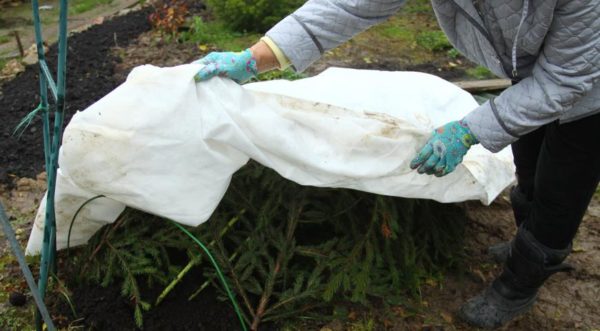
Shoots are elastic and easily bend to the ground
Instances with thick branches are hard to bend to the ground. For this reason, delaying this until November is not recommended. Starting from the last September days, it is necessary to gradually bend the shoots so that the stems can reach the ground in the cold. At the same time, the stems acquire the greatest elasticity on warm days, and with the onset of cold weather they become more coarse - the probability of accidentally damaging the shoots with late bending increases.
Lapnik - the best material
Lapnik is a good material for sheltering rose bushes, but it is difficult to get it in sufficient volumes, especially with large rose gardens. The plant grower has difficulties - in order not to get a fine, you need to contact the leshoz and learn about the planned cuttings, ask for the remaining lapnik and the like. As an equivalent alternative, it is possible to use non-woven material - spanbond, or roofing material. But, it is better to refuse from polyethylene, since this material disrupts moisture exchange and air circulation in the shelter.
The best materials for sheltering bushes
As insulation, it is possible to use purchased materials and improvised means. The most affordable purchased material is a plastic film. Such a heater is recommended for those varieties that do not tolerate frost. But, they wrap it tightly with a film - they keep the air gap. Spanbond is also used, sold in rolls or in packs of 10 m linear. There are several types:
- agricultural span;
- agil;
- lutrasil;
- agrotex;
- agroSUF.
Some plant growers do not buy covering material, but use improvised means for this purpose. The best options are rags, spruce branches, burlap, leaf litter, peat and sand. It is possible to shelter roses with sawdust in the winter. These are imperfect materials for sheltering - the service life of such funds is only 1 winter. In addition, such improvised materials also create difficulties in transportation.
Conclusion
A rose is a decoration of a flower garden and pride of a plant grower, but this plant is somewhat capricious. Bushes often need to organize shelter for the winter, which must be built strictly according to the rules. Depending on the climatic characteristics of the region, you need to choose what type of shelter to do, because if it is too warm, the flower will begin to sing, and if it is cold, it may die.

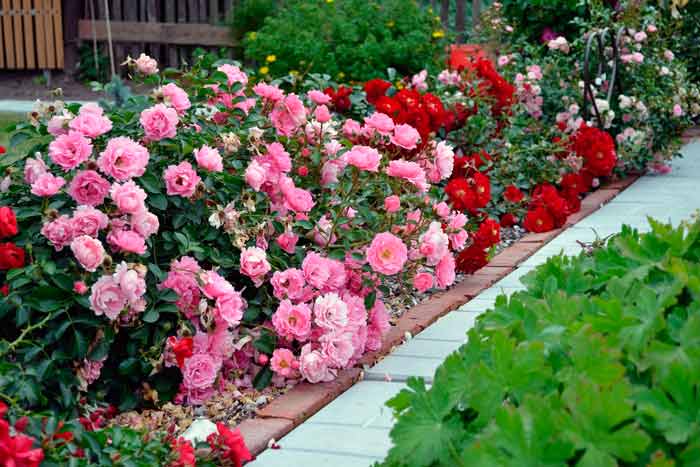 Shelter of roses for the winter: at what temperature does the robot hold
Shelter of roses for the winter: at what temperature does the robot hold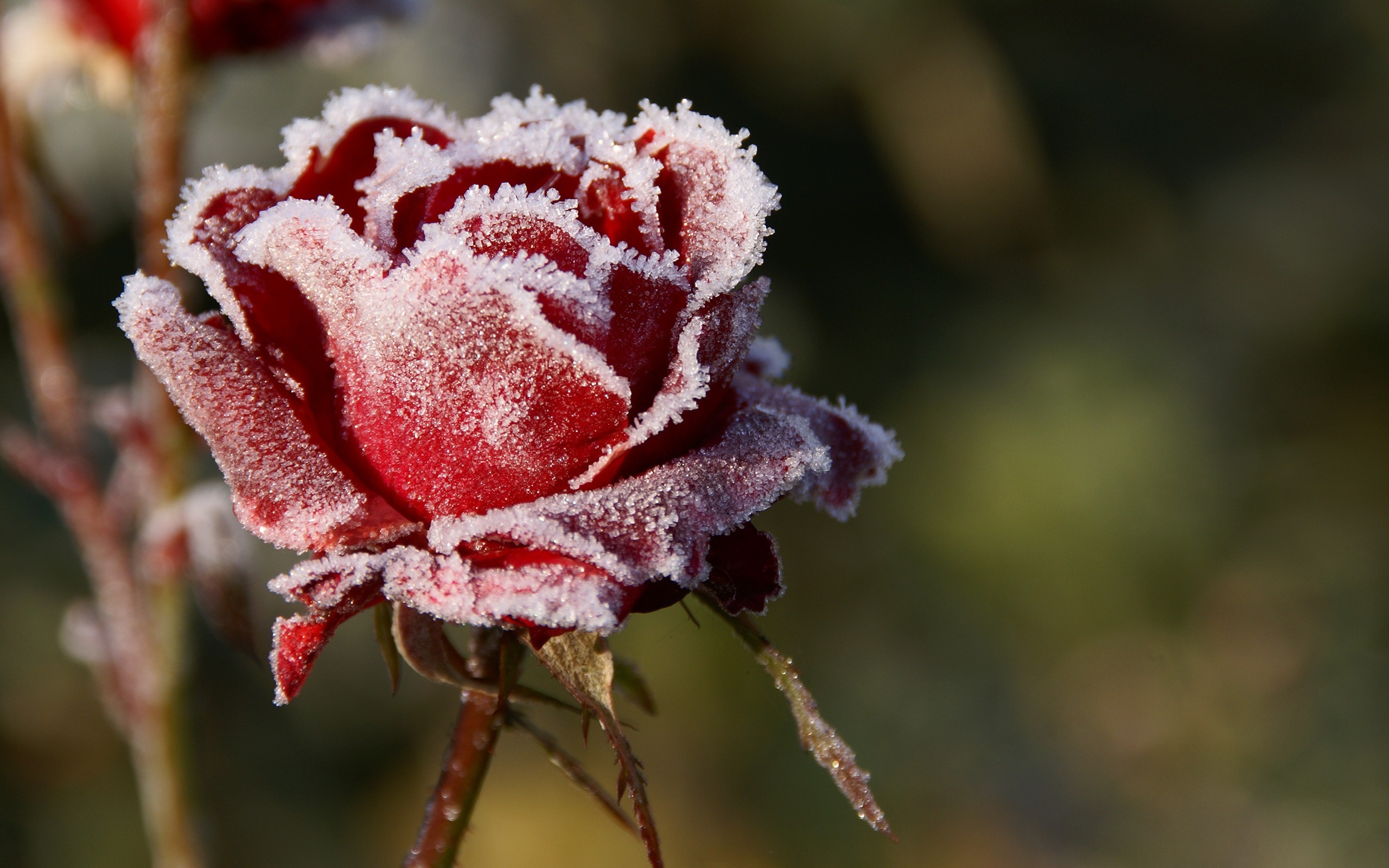 How to prune roses in the fall: timing, pruning rules, pros and cons
How to prune roses in the fall: timing, pruning rules, pros and cons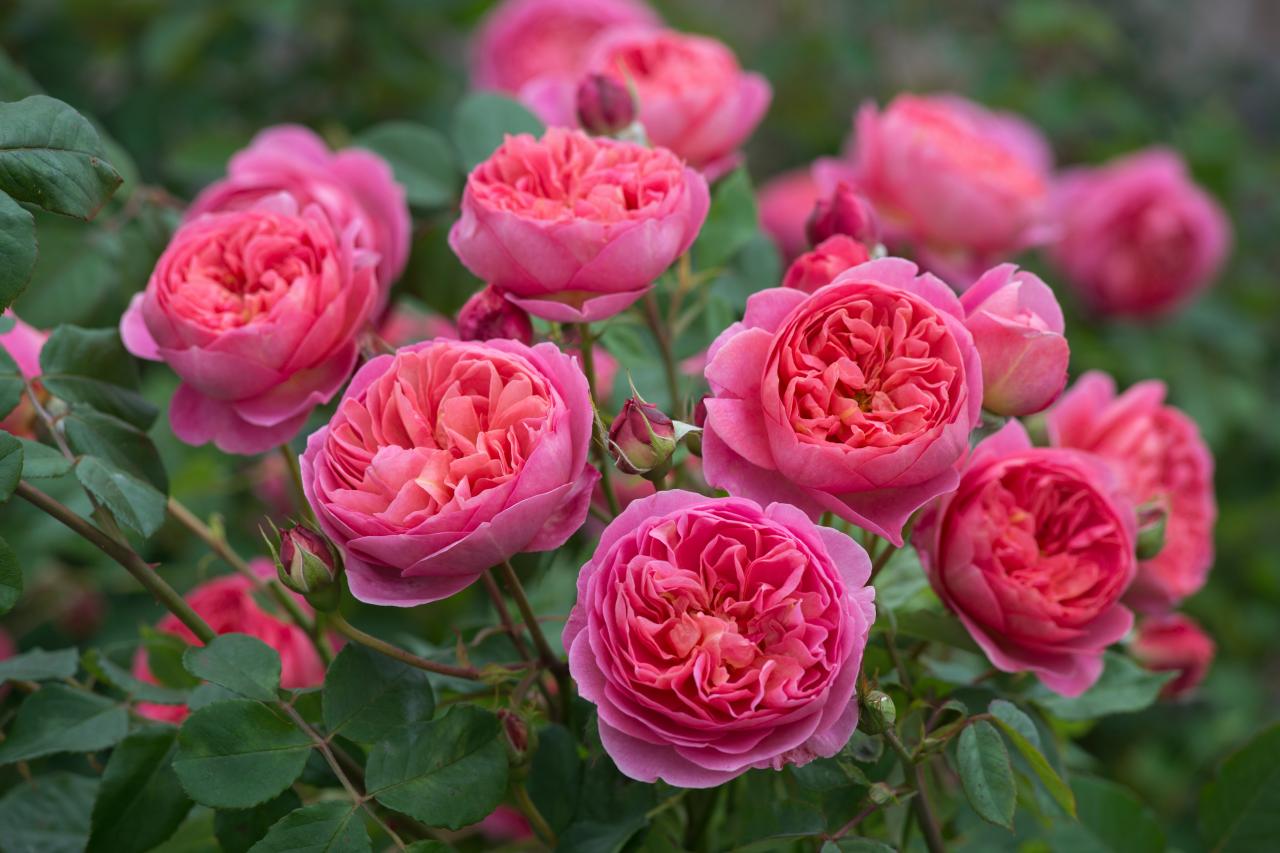 What are the varieties and types of roses
What are the varieties and types of roses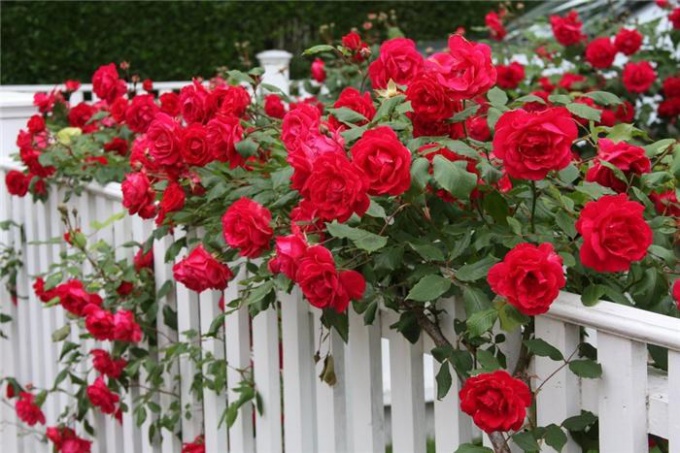 How to process roses with iron sulfate in autumn: proportions, advantages and disadvantages
How to process roses with iron sulfate in autumn: proportions, advantages and disadvantages